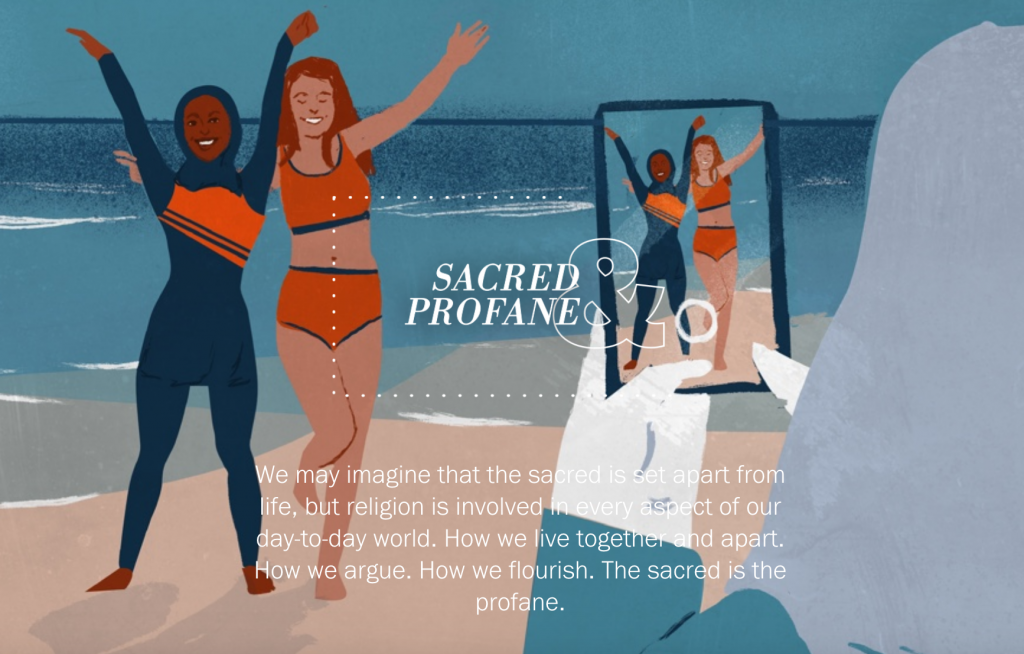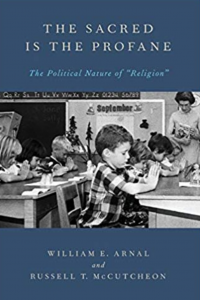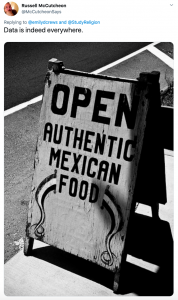 The other day I was looking at UVA’s podcast, now with several episodes (give it a listen), and couldn’t help but notice a nice example of a theoretical and methodological fracture point in the field, one which likely prompts people to pick a side when doing their work.
The other day I was looking at UVA’s podcast, now with several episodes (give it a listen), and couldn’t help but notice a nice example of a theoretical and methodological fracture point in the field, one which likely prompts people to pick a side when doing their work.
For although I agree that “the sacred is the profane,” Bill Arnal and I didn’t quite have this sense of the phrase in mind when picking a title for a set of essays that we collected together and published a few years ago.
 By that title we meant the manner in which naming something as religious or sacred or spiritual or contemplative or mystical or…, was itself a human and thus mundane classificatory act, one with the usual practical effects that attends any act of naming, distinguishing, and ranking (the threefold set of things entailed in classifying something), and thereby (re)producing, negotiating, and contesting identities in the world (processes that make it possible to come to the conclusion that we even inhabit a world, by the way).
By that title we meant the manner in which naming something as religious or sacred or spiritual or contemplative or mystical or…, was itself a human and thus mundane classificatory act, one with the usual practical effects that attends any act of naming, distinguishing, and ranking (the threefold set of things entailed in classifying something), and thereby (re)producing, negotiating, and contesting identities in the world (processes that make it possible to come to the conclusion that we even inhabit a world, by the way).
What we didn’t mean by that was that this thing called religion or spirituality pervaded all of mundane life. But that’s certainly another way one can take that phrase.
The difference?
Well, in one case so-called sacred things (the “so-called” is crucial here) aren’t any different — not whatsoever — from any other element of the mundane world of human doings, though social actors work really hard to create the impression that they are, such as calling so-called religious people on the move “pilgrims” and non-religious people “tourists” — now we study one group differently from the other, since the former are presumed to be on the move for unique or deeper reasons that scholars need to take into account…. (In other words, it would be just a bit insulting to think that they’re “mere” tourists, right?) But in the other case, or so it seems to me, this thing called religion or spirituality or…, is not an identity presumed to be the result of human action but, instead, is thought somehow to predate and pervade all human actions, resulting in it being “involved in every aspect of our day-to-day world,” as the podcast’s image, above, puts it.
It strikes me as a considerable difference in approach and a choice that most in the field end up making as they set off to study religion.
For in one case studying religion will mean learning how the sacred manifests itself (to hearken back to more traditional phrasing that, when I look at the field, still seems as relevant as ever), sometimes doing so in surprising places (the “religion of baseball” approach, we might call it). But in the other, the things called religious etc., will be studied as the results of ordinary human actors arranging their worlds in ordinary ways, by designating something as “set apart and forbidden” (to recall an equally old phrasing, but one associated with a rather different tradition in the field). Maybe people do this to privilege something (or someone) in relation to other things, but it’s just as likely that they do it to demote and delimit — which is what we’ll have to figure out as we dive in to study the larger world that produced these and just these supposedly religious things or people.
It was with this disciplinary distinction in mind that I tweeted a pic the other day in response to a colleague rightly observing that, in our field, “data is everywhere”:
 The question is how can this item be something a scholar of religion would study — whether the sign has religious aspects or effects that we’ll see if we look at it just a bit closer, or, as I’d instead argue, whether the things that we end up calling religion are the result of something no different than the act of setting apart this food from that food, all in an effort to attain some very practical effects (in this case, customers and, presumably, a profit for the restaurant). For now the study of religion is the study of how people identify and order (and yes, contest) their worlds, examined at one particular and manageable place, but with analogues all over the place (including a sign outside a restaurant).
The question is how can this item be something a scholar of religion would study — whether the sign has religious aspects or effects that we’ll see if we look at it just a bit closer, or, as I’d instead argue, whether the things that we end up calling religion are the result of something no different than the act of setting apart this food from that food, all in an effort to attain some very practical effects (in this case, customers and, presumably, a profit for the restaurant). For now the study of religion is the study of how people identify and order (and yes, contest) their worlds, examined at one particular and manageable place, but with analogues all over the place (including a sign outside a restaurant).
So the question now is what do you mean by “the sacred is the profane” and what does it allow you to do in your work?